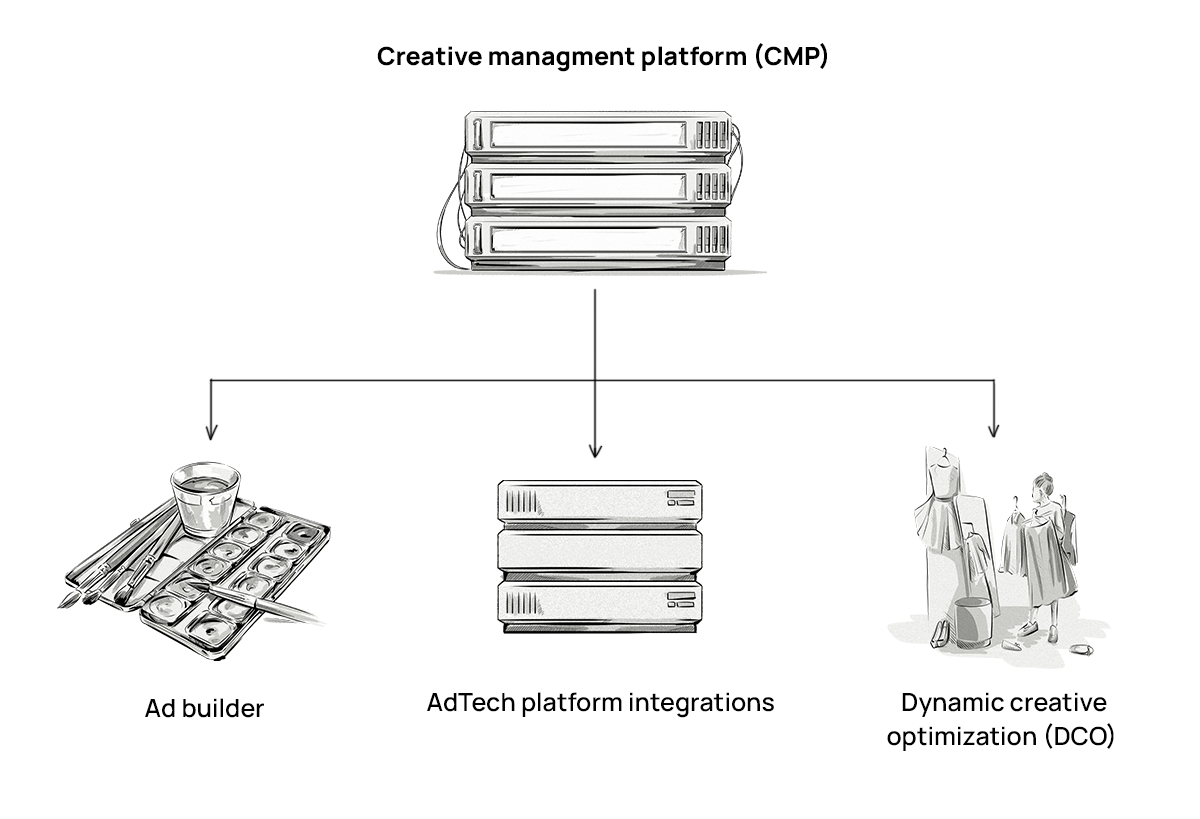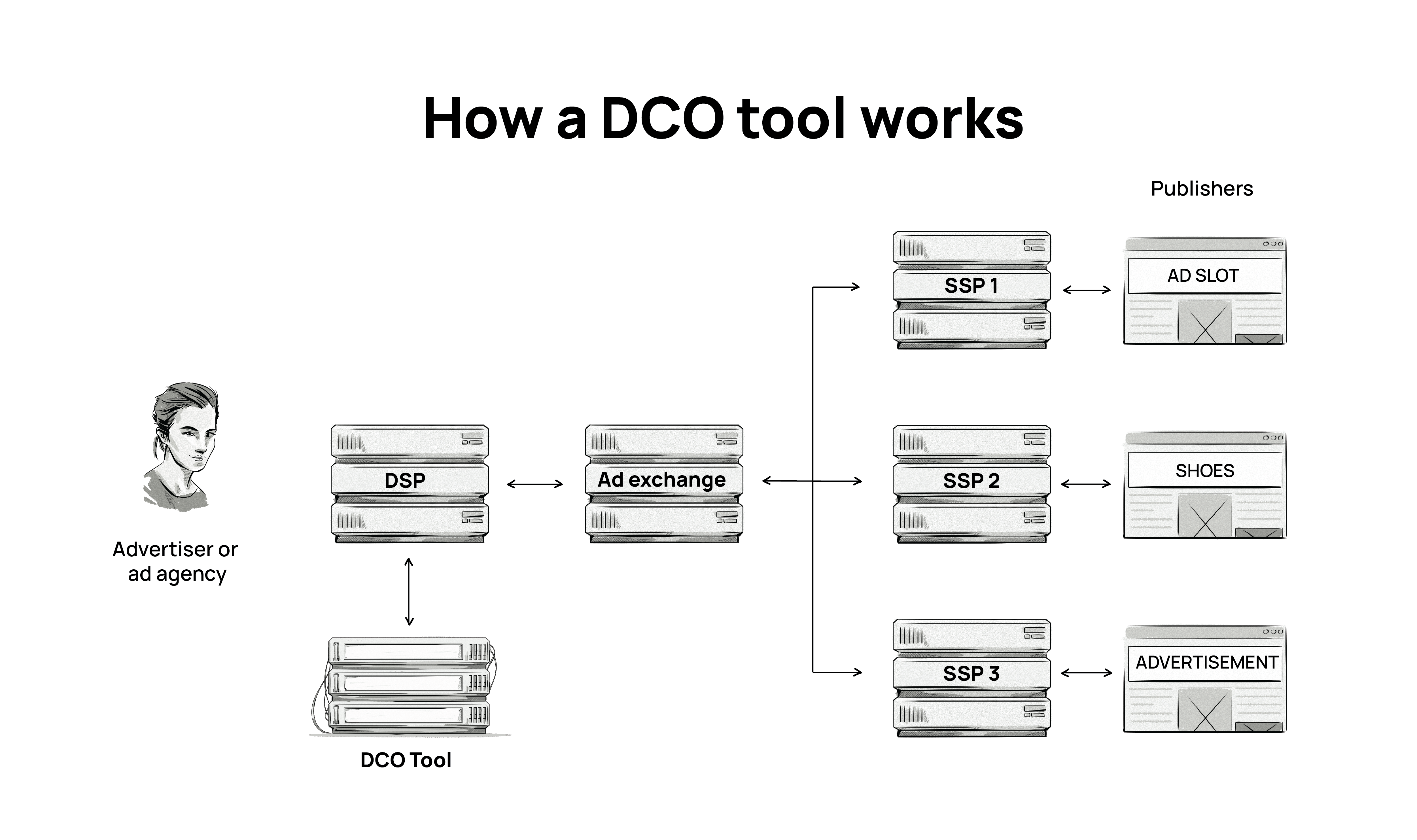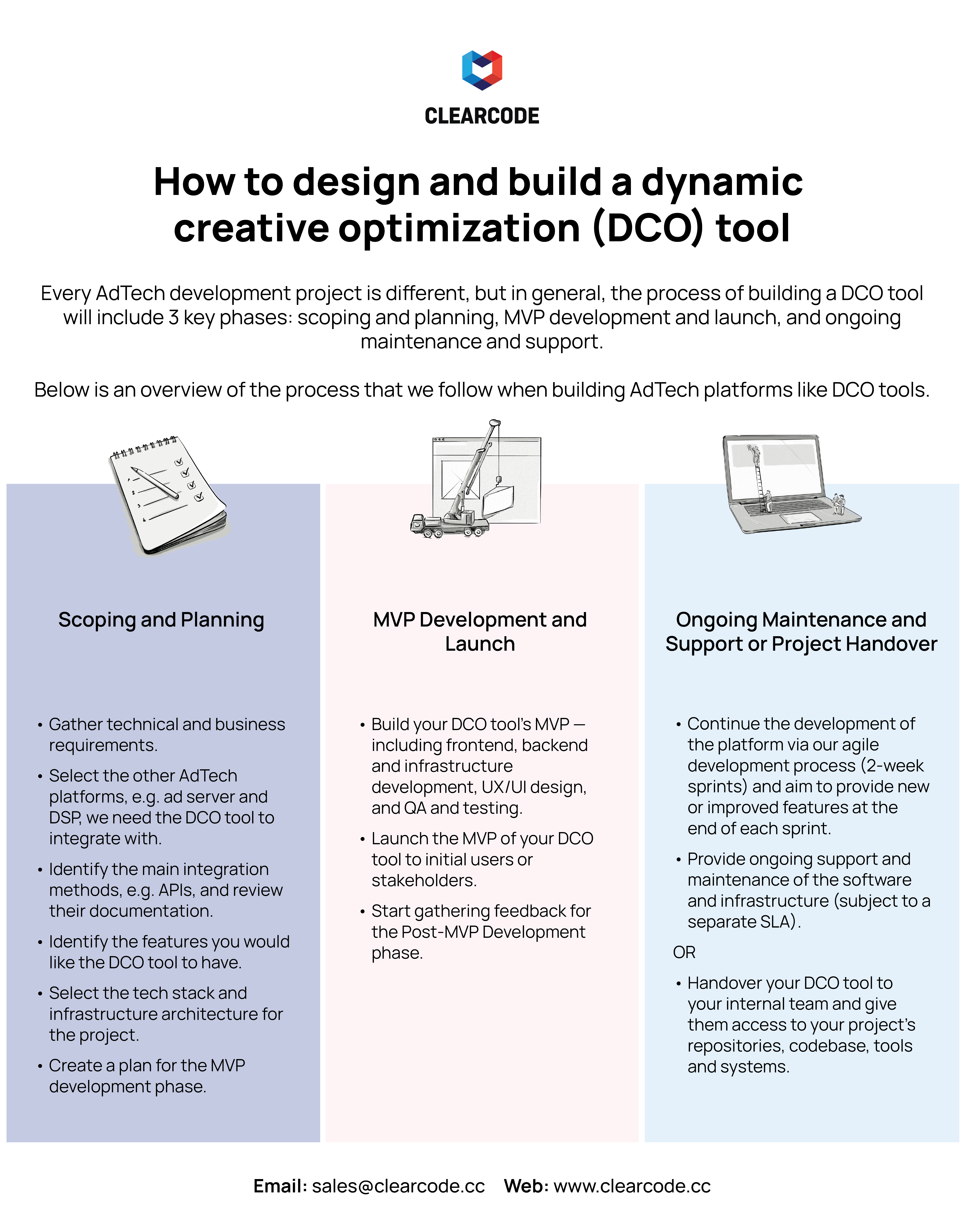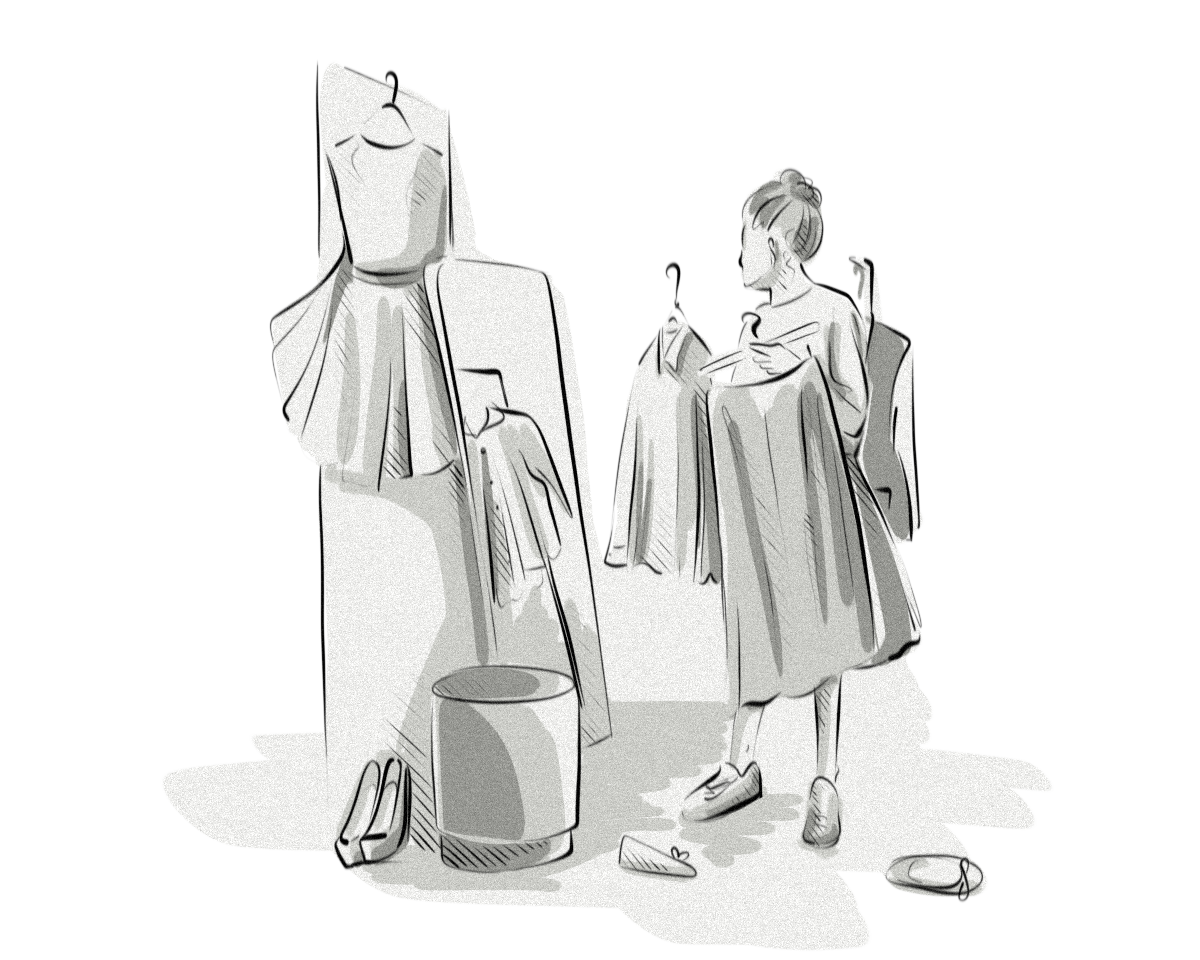The Internet is flooded with advertisements, which is why advertisers implement a number of strategies, tactics, and tools to tailor communication to an individual customer. Dynamic creative optimization (DCO) technology can increase conversions by using your customer data to create a hyper-relevant creative in real-time.
For a dynamic creative to succeed, it must be delivered to the right people in the proper context and time, directly addressing the recipient’s specific needs and interests.
Marketers can achieve this by collecting vast amounts of data containing information about their customers’ behavior, location, and topics currently of interest to create effective ad campaigns.
This article discusses dynamic creative optimization (DCO), who benefits from it, and how you can build your custom DCO tool to get the most out of your marketing efforts.
Key Points
- DCO is a technology that creates hyper-relevant ads based on available information about a potential customer.
- Using the base (underlying creative), DCO prepares and tests dozens of versions of the creative in real-time, selects the most effective one, and serves it.
- DCO is used by companies with a wide range of products, such as e-commerce companies, but also by those that want to reach a specific type of customer, e.g. a person interested in buying a new car.
- DCO is a tool that will help with both upper-funnel campaigns, such as prospecting, and lower-funner campaigns, such as retargeting.
What Is A Dynamic Creative Optimization (DCO) Tool?
Dynamic creative optimization (DCO) is a process whereby advertisers show personalized ads to individual users based on information known about them. The software that powers this process is known as a dynamic creative optimization tool (or platform), which is essentially a piece of advertising technology (AdTech) that is responsible for creating, serving, and measuring these hyper-relevant advertisements to users.
With DCO, different ad components, such as backgrounds, text, main images, value propositions, CTAs, etc., are changed on the fly to achieve the most personalized communication towards a potential client. These elements are created based on the information and data associated with that particular user.
Within the DCO tool, advertisers utilize data about their clients, such as demographic data, geographic locations, interests, contextual data, behavioral data, historical insights, and context-specific data. The DCO tool forms a new creative out of the provided information, tests it in real-time (A/B tests), and displays the best-performing creative at scale.
What differentiates the DCO tool from other types of advertising tech is the usage of data and the creation of dynamic ads in real-time. With the use of these two elements, it is more probable that the potential client will click on the ad and convert (e.g. make a purchase).
Who Can Benefit From a Dynamic Creative Optimization (DCO) Tool?
Marketers can utilize DCO tools across the marketing funnel. This means that they can optimize their campaigns within lower-funnel campaigns, such as retargeting and retention programs, and upper-funnel campaigns, such as brand awareness and prospecting.
In the beginning, the biggest brands and media agencies used DCO tools — especially those who needed to cut down the time it takes to produce individual creatives.
As more and more businesses started to gather more and more information about Internet users, it turned out that DCO is a tool that would work in most verticals.
In general, companies with large product portfolios, sophisticated marketing strategies, and vast amounts of data about users will benefit from DCO tools.
Here are some examples of industries that would benefit from DCO technology:
- E-commerce
- FMCG
- Automotive
- Consumer packaged goods (CPG)
- Financial services
- Healthcare
- Travel services
We Can Help You Build an AdTech Platform
Our AdTech development teams can work with you to design, build, and maintain a custom-built AdTech platform for any programmatic advertising channel.
What Are The Benefits Of Dynamic Creative Optimization?
Many studies showed that static advertising is less effective than dynamic creatives, but improved campaign performance is not the only benefit of adapting DCO technology.
Some of the benefits of DCO include:
Delivering a more appealing ad experience
Advertisers who combine programmatic ad buying and DCO technology and power them with vast amounts of data will deliver a more compelling ad experience.
Boosting the performance of dynamic ads vs. static ads
Advertisers will gain more engagement, higher CTRs, and conversions from relevant and more personalized ads compared to static ads that serve less- or non-personalized content.
Optimizing ad elements
DCO algorithms optimize ad components to provide advertisers with the most significant results by changing various elements of an ad, such as headlines, prices, CTAs, backgrounds, etc.
Time and cost savings
Companies with vast amounts of products and services cut down the time required to produce and serve their ads with DCO. By using a DCO tool, you can create an almost unlimited number of ad variations and serve them in various ad formats. Everything happens on the fly, so the tool reduces ad production and delivery costs.
DCO can be constantly fed with data
To work, the tool needs data feeds powered with relevant data. Data can come from demand side platforms (DSPs), data management platforms (DMPs), customer relationship management platforms (CRMs), etc. Once the data feed is set up, the delivery of modified ads becomes automated with a relatively low effort to maintain.
A DCO tool can be used with display, social, video and audio ads.
What’s The Difference Between A Dynamic Creative Optimization (DCO) And Other Forms Of Ad Targeting?
DCO is sometimes confused with other forms of ad targeting. Most often, you will see the comparison of DCO to dynamic creatives or creative management platforms (CMP).
We explain the differences below.
Dynamic Creative Optimization vs Static Creative
There are similarities between DCO and a static creative as both can use A/B testing to define the most effective ads. But besides that aspect, there’s not much in common.
DCO uses dynamic content, meaning that it changes the parts of an ad based on specific information. DCO also uses AI and ML to optimize the results of digital campaigns. On the other hand, static creatives cannot be changed, even if you have helpful context-related data.
Dynamic Creative Optimization vs Dynamic Creatives
Although DCO is sometimes abbreviated as dynamic creatives, they are not the same form of advertising. The main difference lies not in the dynamic change of content but in machine-learning (ML) mechanisms.
Dynamic creatives are most often used in simple retargeting campaigns: a viewer enters a website and views several products. The user would then be shown ads for these products as they browse different websites. The content can be changed but will not be optimized.
DCO tools, on the other hand, use ML and algorithms to tailor ads, test them on a smaller audience, and show ads with a high success rate. The optimization element is crucial to distinguish dynamic creative from dynamic creative optimization.
Dynamic Creative Optimization vs Creative Management Platforms (CMPs)
Dynamic creative optimization (DCO) and creative management platforms (CMPs) are gaining momentum today as the latest AdTech innovation promises to save millions on creative production costs.
CMPs are cloud-based AdTech solutions to help digital marketers create, test, and improve their creatives. Their engines produce and control the design versions of ads required for a DCO campaign.
Typical elements of a CMP are:
- Ad builder (to design ads and their components).
- A publishing solution with an ad server or ad network connection to serve the ad.
- Additional tools such as analytics and a creative optimization engine.
DCO is considered the process of serving and optimizing ads. So in simple words, a CMP is responsible for the creative part, and DCO for the testing and serving part.

A Data Management Platform (DMP) for DCO
A data management platform (DMP) is a piece of software that gathers, organizes, and analyzes data from all interactions your clients and potential clients have with your brand.
Digital touchpoints like interactions with your website, marketing campaigns, and social media platforms are examples of this.
In your customer relationship management (CRM) system, offline touchpoints include contact center queries, order history, personal information, contract renewal, and warranty information. Of course, it also consists of data from other parties as well.
Real-time data from these systems and linked data sources are sent to your DCO tool by your DMP.
How Does a Dynamic Creative Optimization (DCO) Tool Work?
To serve dynamically created and optimized ads, a DCO tool needs to integrate with a few existing advertising technology platforms, such as demand side platforms (DSP) and ad exchanges. From there, it utilizes data feeds and machine-learning algorithms to produce the creatives.
To get a picture of how a DCO tool works, let’s start by looking at how it fits into the real-time bidding (RTB) process.
When a user visits a website, a supply-side platform (SSP) sends a bid request to an ad exchange, which then passes it on to all the DSPs that it integrates with. To return a bid, the DSPs need to evaluate the information known about that user and then see if it matches the targeting criteria for one of their campaigns.
Once the DSPs have returned a bid response, the ad exchange picks the winning bidder (i.e. the highest bidder) and the ad is to be shown on the publisher’s website.
Prior to displaying an ad to the user, the DSP sends an ad call to the DCO, and a hyper-relevant ad is created and delivered to the user. This all takes place in less than 100 milliseconds.

Does Dynamic Creative Optimization Use Third-Party Cookies?
Dynamic Creative Optimization relies on third-party cookies and data feeds. The most common use case of DCO is a retargeting campaign.
Three “layers” are involved in serving hyper-relevant ads: the first is the browser, the second is the user profile, and the third is the data feed.
To run a hyper-relevant ad campaign (e.g. retargeting campaign), the advertiser needs to put a pixel on their website, which then builds audience segments.
The DCO tool’s cookie, placed in a user’s browser, collects information about the website visitor. With the help of the pixel, it also gathers information on dynamic content triggers, e.g., a product ID, and builds out a user profile.
The DCO tool then needs a data feed to serve ads. The data feed may include information like product ID, description, category, price, image URL, promotional copy, etc.
The captured product ID in the user’s profile triggers the content within the data feed and then creates a relevant ad.
With the decreasing availability of third-party cookies, many DCO tools have started utilizing universal IDs as an alternative.
Dynamic Creative Optimization Use Cases
DCO can boost almost any digital campaign. The following use cases highlight where the tool can be beneficial:
Location-based customization: You can modify creatives to match regional preferences or details about the company’s local offerings. The same applies to demographic and behavioral variables.
Retargeting campaigns and promotions: You can encourage consumers to convert by dynamically optimizing ads with down-sales, cross-sales, and special promotions. You can also show your ads to consumers who expressed intent in buying your products (e.g. abandoned a shopping cart and visited a particular product page)
Contextual targeting: You can modify creatives to be more appealing to visitors of specific pages, allowing the ads to deliver a seamless user experience.
How To Build a Dynamic Creative Optimization (DCO) Tool
The image below illustrates the process we follow here at Clearcode to design and build AdTech platforms, including DCO tools.

We Can Help You Build an AdTech Platform
Our AdTech development teams can work with you to design, build, and maintain a custom-built AdTech platform for any programmatic advertising channel.








